Crossref Citations
This article has been cited by the following publications. This list is generated based on data provided by Crossref.
Ramalho, M
Guibu, L S
Giannini, T C
Kleinert-Giovannini, A
and
Imperatriz-Fonseca, V L
1991.
Characterization of some southern Brazilian honey and bee plants through pollen analysis.
Journal of Apicultural Research,
Vol. 30,
Issue. 2,
p.
81.
Heard, Tim A.
1999.
THE ROLE OF STINGLESS BEES IN CROP POLLINATION.
Annual Review of Entomology,
Vol. 44,
Issue. 1,
p.
183.
MORETI, AUGUSTA CAROLINA DE CAMARGO CARMELLO
CARVALHO, CARLOS ALFREDO LOPES DE
MARCHINI, LUÍS CARLOS
and
OLIVEIRA, PATRÍCIA CANTALINO FERNANDES DE
2000.
Espectro polínico de amostras de mel de Apis mellifera L., coletadas na Bahia.
Bragantia,
Vol. 59,
Issue. 1,
p.
01.
Pick, Raquel A.
and
Blochtein, Betina
2002.
Atividades de coleta e origem floral do pólen armazenado em colônias de Plebeia saiqui (Holmberg) (Hymenoptera, Apidae, Meliponinae) no sul do Brasil.
Revista Brasileira de Zoologia,
Vol. 19,
Issue. 1,
p.
289.
Barth, Ortrud Monika
2004.
Melissopalynology in Brazil: a review of pollen analysis of honeys, propolis and pollen loads of bees.
Scientia Agricola,
Vol. 61,
Issue. 3,
p.
342.
Antonini, Yasmine
Soares, Sandra Matoso
and
Martins, Rogério Parentoni
2006.
Pollen and nectar harvesting by the stingless beeMelipona quadrifasciata anthidioides(Apidae: Meliponini) in an urban forest fragment in Southeastern Brazil.
Studies on Neotropical Fauna and Environment,
Vol. 41,
Issue. 3,
p.
209.
Kajobe, Robert
2007.
Pollen foraging by Apis mellifera and stingless bees Meliponula bocandei and Meliponula nebulata in Bwindi Impenetrable National Park, Uganda.
African Journal of Ecology,
Vol. 45,
Issue. 3,
p.
265.
Marques-Souza, Antonio Carlos
Absy, Maria Lúcia
and
Kerr, Warwick Estevam
2007.
Pollen harvest features of the Central Amazonian bee Scaptotrigona fulvicutis Moure 1964 (Apidae: Meliponinae), in Brazil.
Acta Botanica Brasilica,
Vol. 21,
Issue. 1,
p.
11.
Pacheco, Marta Rodrigues
Barth, Ortrud Monika
and
Lorenzon, Maria Cristina
2009.
Tipos polínicos encontrados em colônias de abelhas africanizadas sujeitas à doença cria ensacada brasileira.
Ciência Rural,
Vol. 39,
Issue. 7,
p.
2141.
Marques-Souza, Antonio Carlos
2010.
Ocorrência do pólen de Podocarpus sp. (Podocarpaceae) nas coletas de Frieseomelitta varia Lepeletier 1836 (Apidae: Meliponinae) em uma área de Manaus, AM, Brasil.
Acta Botanica Brasilica,
Vol. 24,
Issue. 2,
p.
558.
Vossler, Favio Gerardo
Tellería, María Cristina
and
Cunningham, Mónica
2010.
Floral resources foraged byGeotrigona argentina(Apidae, Meliponini) in the Argentine Dry Chaco forest.
Grana,
Vol. 49,
Issue. 2,
p.
142.
Faria, Letícia Biral de
Aleixo, Kátia Paula
Garófalo, Carlos Alberto
Imperatriz-Fonseca, Vera Lucia
and
Silva, Cláudia Inês da
2012.
Foraging ofScaptotrigonaaff.depilis(Hymenoptera, Apidae) in an Urbanized Area: Seasonality in Resource Availability and Visited Plants.
Psyche: A Journal of Entomology,
Vol. 2012,
Issue. ,
p.
1.
Kajobe, Robert
2013.
Pot-Honey.
p.
315.
Aleixo, Kátia Paula
Faria, Letícia Biral de
Garófalo, Carlos Alberto
Imperatriz Fonseca, Vera Lucia
and
Silva, Cláudia Inês da
2013.
Pollen Collected and Foraging Activities of Frieseomelitta varia (Lepeletier) (Hymenoptera: Apidae) in an Urban Landscape.
Sociobiology,
Vol. 60,
Issue. 3,
p.
266.
Obregon, D
and
Nates-Parra, G
2014.
Floral Preference of Melipona eburnea Friese (Hymenoptera: Apidae) in a Colombian Andean Region.
Neotropical Entomology,
Vol. 43,
Issue. 1,
p.
53.
Miranda, E. A.
Carvalho, A. F.
Andrade-Silva, A. C. R.
Silva, C. I.
and
Del Lama, M. A.
2015.
Natural history and biogeography of Partamona rustica, an endemic bee in dry forests of Brazil.
Insectes Sociaux,
Vol. 62,
Issue. 3,
p.
255.
Vélez-Gavilán, J
2016.
Alves-dos-Santos, Isabel
Silva, Claudia Inês da
Pinheiro, Mardiore
and
Kleinert, Astrid de Matos Peixoto
2016.
Quando um visitante floral é um polinizador?.
Rodriguésia,
Vol. 67,
Issue. 2,
p.
295.
Aleixo, Kátia Paula
Menezes, Cristiano
Imperatriz Fonseca, Vera Lúcia
and
da Silva, Cláudia Inês
2017.
Seasonal availability of floral resources and ambient temperature shape stingless bee foraging behavior (Scaptotrigona aff. depilis).
Apidologie,
Vol. 48,
Issue. 1,
p.
117.
Lichtenberg, Elinor M.
Mendenhall, Chase D.
Brosi, Berry
and
Ings, Thomas
2017.
Foraging traits modulate stingless bee community disassembly under forest loss.
Journal of Animal Ecology,
Vol. 86,
Issue. 6,
p.
1404.



